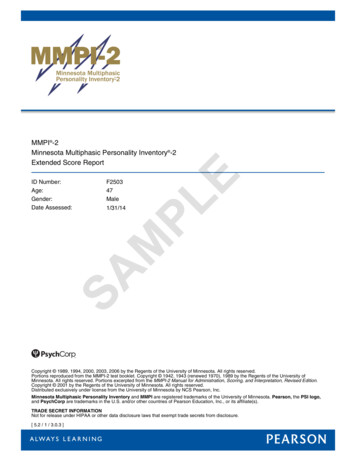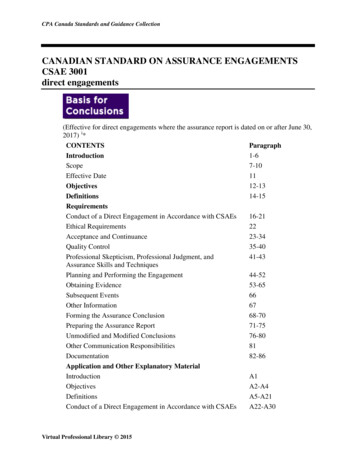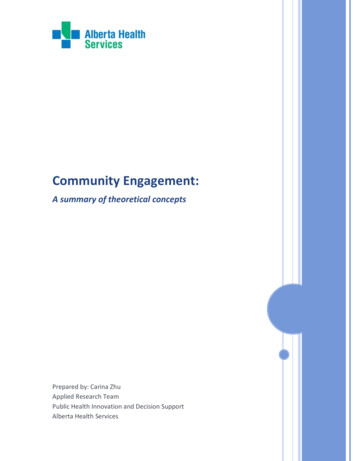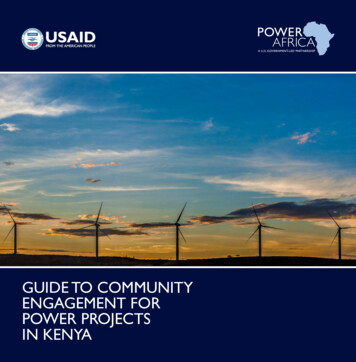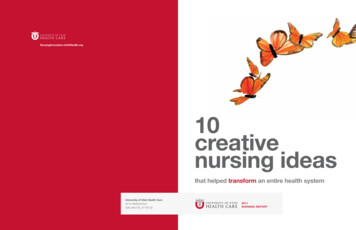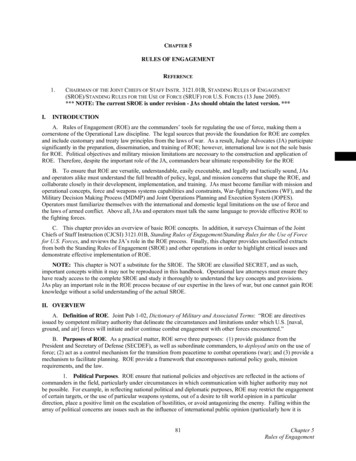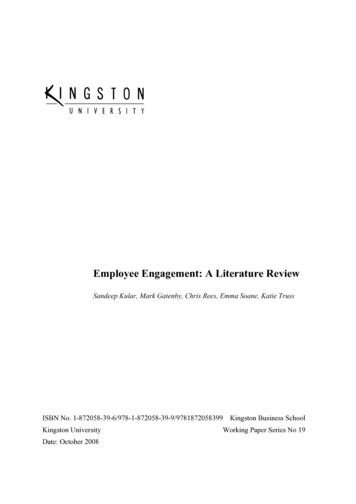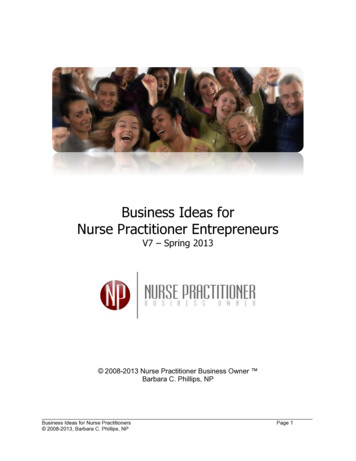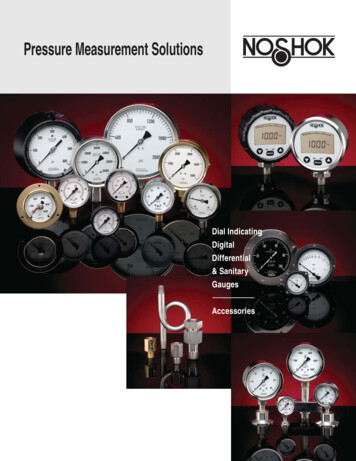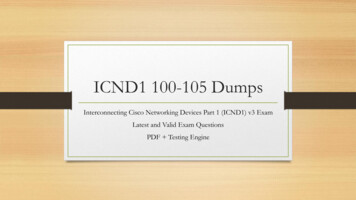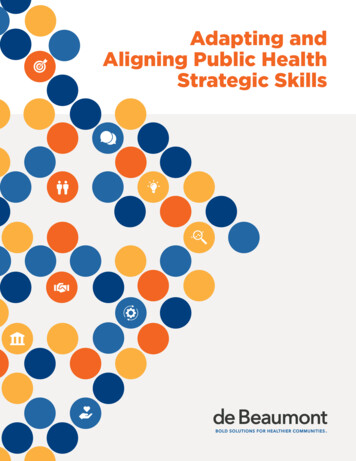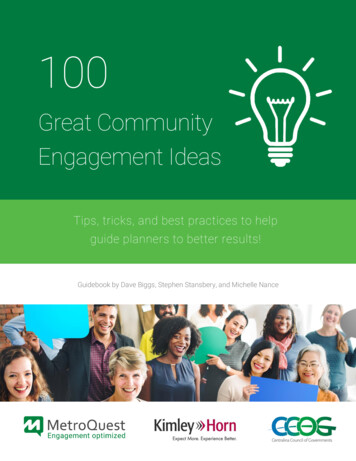
Transcription
100Great CommunityEngagement IdeasTips, tricks, and best practices to helpguide planners to better results!Guidebook by Dave Biggs, Stephen Stansbery, and Michelle Nance
IntroductionThere are many benefits to great community engagement for planning projects. Successfulengagement can inform and shape plans that better meet the needs of the community,generate much needed stakeholder support, and save time and resources by facilitatingplan implementation.Great community engagement means hearing from a large and diverse audience andcollecting meaningful public input to inform decisions. While each situation is unique, thereare many proven strategies that can be used by project teams to tame emotionalstakeholders, engage even hard to reach populations, and collect informed input to get thebest out of their community engagement.The challenge is that public participation for planning projects has never been easy, and inmany communities, it’s getting more difficult. Agencies frequently complain about lowturnouts at public meetings or emotionally-charged opposition from individuals or groups.While it’s evident that, for many agencies, community engagement is in crisis, there areplenty of planning agencies that are achieving outstanding results. We have many reasonsto be optimistic.A Community Engagement Guidebook forPlanners by PlannersWhat inspired this guidebook? It was time to take stock of what’s working well across thecountry so that all agencies can benefit from the tactics that have led to success. Whileplanners and public engagement professionals have their shareof success stories, tips, and best practices, it was also clear thata critical resource was missing: a guidebook to help projectleaders design outstanding public participation programsthat fit their project goals and budgets.In April 2018, over 150 members and friends of theAmerican Planning Association came together tobrainstorm great community engagement ideas.2Guidebook
While we are simply stewards of their great ideas, let us introduce ourselves: Dave Biggs,Chief Engagement Offer at MetroQuest, Michelle Nance AICP, Planning Director at theCentralina Council of Governments, and Stephen Stansbery AICP, National MobilityPlanning Practice Leader at Kimley-Horn.This year, at the American Planning Association National Planning Conference in NewOrleans, we facilitated a workshop entitled “Public Engagement Gone Wild? TamingTactics!” attended by planners from across the nation. They generated over 500 ideas, tips,and strategies for great community engagement.In this guidebook, we’ve amalgamated, categorized, and summarized the best 100 tips forsuccess. It is designed to help planners and public engagement teams create andimplement public participation programs that are open, transparent, and welcoming to allcommunity members, while also ensuring that the process is resilient and robust, guardingagainst the possibilities of bias, intimidation, and sabotage by community groups orindividuals seeking to disrupt the process.We have divided the community engagement process into nine key components. For eachsection, you’ll find a series of questions to spark your thought processes and a list of ideasand tips. It’s our hope that referencing this guidebook early in the project design processwill become standard practice for all planning and engagement teams. These questionsand lists are meant to spur discussions and generate ideas to help you develop the mosteffective public participation plan possible for your projects. Feel free to use the ideas thatresonate and can be accomplished by your team, within your budget and time frame.3Guidebook
1Audience DefinitionAn effective public engagement process starts by having a clear idea of who you want toreach. Resources naturally dictate that we can’t engage 100% of the population. A targetedapproach will ensure that interested and impacted stakeholders are at the tablethroughout the process.Why is audience definition important? Some engagement techniques work better for specific audiences. If you don’tidentify and gain clarity on your core audiences, you can run afoul when developingyour engagement process, strategies, and tools. Audience definition is aprerequisite to process design. Determining your audience dictates how much education will be needed prior toobtaining input. Having a clear understanding of the time needed for education willhelp you stay on track. Identifying critical audiences early in the process reduces time and risk and thepotential for re-work.When determining the core audience for a process, there are several questions to consider. What groups need to be reached?What demographic targets are needed?Who must be involved for this effort to be deemed a success?Ideas collected from our APA “Taming Tactics” session revealed a variety of goals andstrategies to consider during your audience definition process.4Guidebook
Know Your Audience1.Define "the public" – It’s easy to assume that everyone has the same definition ofthe audience for public engagement. To be sure everyone is on the same page, it’sbest to be explicit early on so that everyone – from elected officials to engagementstaff and the community itself – knows who is included. This may mean spellingout that it’s not limited to people of voting age, locals, nor property owners.2.Recognize the diversity of perspectives – For controversial projects, you often knowahead of time about opposing groups or individuals. It’s important to take the timeto understand both sides. Meet with these groups in advance of broaderengagement to discuss the facts as known at the time. Have a true dialogue thatincludes an open mind and active listening to hear their specific interests. Often,you will find that there are similar interests, which can lead you toward consensuspoints later in the process. For controversial topics, getting information andspecific facts out early can be beneficial, which can be done through a frequentlyasked questions sheet, social media campaign, or face-to-face meetings.3.Know who influences decision makers – It’s important to know who influences thepeople making the final decisions on a plan or process. Every community isdifferent, but common influencers include large employers, social organizationleaders, public sector agencies, large land owners, and business leaders. Conductresearch to determine what issues are relevant to them, anticipate how the projector program might impact or benefit them, and provide a role for these influencersin the process.Basic Inclusivity4.Understand the demographics – This basic component is foundational to publicengagement work. As part of the public engagement plan, use demographicanalysis to better understand the make up of the community at stake and toprovide context. This is important because there tends to be a strong correlationbetween context, values, and priorities. Go beyond age, race, and income to look athealth indicators such as prevalence of chronic disease and opioid deaths and howaverage lifespan differs across the community. Look at households without a car,crime statistics and type, commuting patterns, and scan for concentrations ofother social indicators that might impact the project or program. Document thefindings and how key discoveries could impact the project.5Guidebook
5.Track participation – While this sounds like a simple step, it is often overlooked astime and resources become focused on education and gathering input. Tomeasure your success towards engaging a variety of stakeholders, ask for basicdemographic information on in-person and online surveys, take photos atmeetings, use a map exercise at meetings to illustrate where people live, work, andplay. Track the number and location of meetings. While it’s often difficult toprovide a one-to-one comparison, hosting meetings at a variety of times andplaces, and making it easy for people to attend will help to ensure that the processincludes a wide variety of people and perspectives.6Guidebook
2The Role of the PublicDeveloping clarity on the role that the public will play in the planning process is a criticalfirst step in developing your community engagement plan. A mismatch of expectations onthe role of the public can lead to frustration and conflict that can derail any planningprocess. Transparency and clarity upfront, on the other hand, can foster trust and build thecommunity and stakeholder support that’s needed to support your plan through tosuccessful implementation.There are a few central questions to address first internally that will also help maintainclarity with participants during the engagement process: What do you expect from the public?Where in the process is public influence most important?Are you clear about both?Ideas collected from our APA working session revealed a variety of goals and strategies toconsider when defining the role of the public.Get Clarity Early On6.Clearly define the topic and purpose – Clarity and transparency are such criticalaspects of successful community engagement that they warrant very closeattention at every step of the process, from the first internal conversations to thedissemination of the results. Too often mismatched expectations fuel conflict that,if allowed to fester, can derail a project. The International Association for PublicParticipation has developed a spectrum to provide clarity on the role for public.Specifically consider communicating clearly on: 7What is the need for the project?What could be the consequences of inaction?Guidebook
7.What are the roles and responsibilities of the public, planners, boards,councils, etc.?Who are the decision makers?Why is public input needed?What information needs to be gathered?How is the public input going to be used?What’s on the table and what are the constraints or limitations?Outline and communicate the rules of engagement – Whether you are conductingonline or face-to-face engagement, establish clear guidelines for conduct. Theseground rules should be well thought out, carefully crafted, and communicated atthe beginning of the process. The tone of these should emphasize listening tounderstand, mutual respect, and creating equal opportunity for input without fearof intimidation or ridicule. To avoid an “us and them” dynamic, it can be useful toinvite participants to play a role in facilitation or reporting.Plan for Deep Engagement8.Weave in the education needed for informed input – Community engagement is notonly about collecting input. Planning choices can be complicated, and for thisreason, it’s wise to weave in education into the engagement process. It’s naïve tosimply provide documentation, because it is seldom read by participants. Withcareful planning and tool selection, it’s possible to embed the required learninginto the engagement experience. Interactive engagement tools like budgetallocation, scenario or image ratings, visual preference surveys, and map inputexercises either online or in face-to-face session can be helpful in ensuring that theinput that is gathered is informed, relevant, and trustworthy.9.Encourage deep listening – Never forget that the primary role for publicengagement is to listen deeply to the community. Well designed engagementprograms will create a safe place for people to share feedback either briefly or indetail at their discretion. Some of the most fruitful and often cathartic engagementexperiences, particularly for contentious projects, involve peer-to-peer exchangesin small, randomly assigned groups – giving people a safe way to learn about otherperspectives. Involving participants in both leading and reporting back from groupdiscussions can be a powerful way of creating deep engagement.8Guidebook
Get Cozy10. Review the results with the public – It’s important to remember that the public input(the data), in some sense, belongs to the participants. The role of planners is to beresponsible stewards of that resource. A best practice is to verify what you heardby asking, “did we get that right?” and “what did we miss?” Be sure to reinforce thevalue of public participation at the end of the process by communicating how theplan was affected by public input.11. Draw in critics – It’s natural to want to avoid conflict, but in the case of communityengagement, this stance can intensify animosity. Early, active, and frequentpersonalized engagement of opposed individuals and groups can be a powerfulway to listen deeply to their concerns, share details about constraints and projectoptions, and draw them into a collaborative role to find solutions.12. Empower participants – People closest to the issues often have the best solutions.Seek to turn participants into project representatives. Empower the audience byproviding them with key roles to play that will give them a sense of purpose.Examples include creating a stakeholder committee, asking stakeholders to helprun a meeting, having a clear “ask” of the audience by assigning homework, or“deputizing” citizens to be planners for the day to develop their own solutions.Encourage citizens to become problem solvers.9Guidebook
3Success DefinitionSuccessful engagement requires documenting the thoughts of advocates, while alsoidentifying public values and stakeholder priorities. Advocates are quick to participate andtypically make themselves more accessible to the planning process. Gaining input from abroader cross-section of the community often proves more difficult, and a planningprocess with underrepresentation from the public can lead to unanticipated consequencesor a narrowly supported outcome.Successful plans share a common characteristic: the engagement goals are clearly defined.Without goals, how can planners know when engagement success has been achieved.While goals are not universal, planners should consider the following questions whendeveloping their project-specific goals. Time – What is the project schedule? What can be accomplished in that timeframe? Resources – What human and financial resources are accessible to the planning process? How can you leverage partnerships and previous engagement efforts?History – How well have past plans used participant input? Leadership – Does community leadership value engagement results?In a perfect world, these circumstances would be ideal for every planning process andevery voice in the community would have the time, interest, and opportunity to effectivelyparticipate. But often in practice, participation is compromised by forces beyond aplanner’s influence. Planners should embrace imperfection and continually consider tradeoffs – it’s not unusual for a process to be successful despite a more flexible adherence toengagement goals. Simple metrics, such as increasing the number of touchpoints, thediversity of viewpoints, and the quality of data points, can elevate engagement results to alevel equal to technical data.10Guidebook
Ideas collected during our “Taming Tactics” session revealed a variety of opinions on theappropriate aspirational goals for planning processes.Involve Leadership13. Get management buy-in – Involving leadership in goal setting fosters awarenessand shared responsibility. It also can give them new awareness about pastperformance and the value of improvement. Showing leaders what it takes to besuccessful might make them more inclined to offer additional resources to theengagement strategy.Monitor Progress and Be Willing to Change Course14. Measure your success – The phrase “you only achieve what you measure” shouldbe at the forefront of the planner’s mind during goal setting. It’s easy to becomedistracted during a complicated, multifaceted planning process, but it’s importantnot to forget this vital step.15. Be nimble on the journey – If identifying goals and monitoring progress are helpful,a willingness to be responsive shows commitment to them both. Staying the courseis often easier but being nimble increases the likelihood that goals are achieved. Astatus check after the first round of engagement is critical. If the chosen methodsare not leading to the desired results, it’s important to change course.Celebrate Success16. Rejoice in shared achievements – As a plan nears completion, the public, projectcommittee, elected officials, and the project team tend to be exhausted. However,the final stage is the perfect time to reflect on successes and milestones. It’s rare toexceed all goals, and planners should allow themselves the right to define successincrementally. Maybe it’s simply achieving more than the last plan. Maybe it’sreaching most goals, but not all. Maybe it’s achieving everything the process wassupposed to accomplish. Regardless, the outcomes are worth sharing andcelebrating. After all, planning done right is a shared process and a shared result.Planners should memorialize the participation, make a video, send a thank youletter to committee members, brag about the community to the media, take anelected official to a conference, and spend time reflecting with their team. Thisaffirmation will inspire everyone to seek the same success, and more, when thenext plan comes along.11Guidebook
4Process DesignIf “defining success” is identifying, vetting, and communicating engagement goals, then“process design” is how planners determine the best way to use available resources byanswering the following questions. What information needs to be gathered from participants? At what point in the process are engagement results needed to inform decisions?What resources are available for engagement?How can these resources be used most effectively to achieve the project goals?Planners at the APA “Taming Tactics” session identified several key factors that should beconsidered during process design.17. Begin drafting the process design early on – Design the process early and allow it toinform a more detailed work plan and scope of services.18. Welcome stakeholders – Consider forming a public engagement committee toensure diverse perspectives, the best use of community resources, and fullexposure to existing communication channels.19. Acknowledge that there are different strokes for different folks – Recognize thatmultiple engagement channels (e.g., one-on-one, small group, large format, virtual)will be necessary and should be influenced by the public engagement goals.While every plan should be tailored to specific circumstances, the rational planning processshould still be the framework to assemble a solid engagement process. The rationalplanning process is described next in five ordered steps. Tips are included in each step toguide the process to success.12Guidebook
Step 1: Identify Community Values and Priorities20. Mine the past – During the initial engagement process, planners should mine pastengagement efforts for recurring themes and investigate relevant plans to inspireparticipants. Previous efforts are likely to have a great deal of valuable informationand by building on them, planners can avoid asking the same questions again andbegin the process armed with insight into the priorities of the community.21. Take the temperature – Testing how applicable the public and various committeesfind previous efforts is critical to visioning. Planners can avoid past mistakes ormissteps and design engagement to address any shortcomings.Step 2: Define the Problem or Opportunity22. Be as specific as possible – A vaguely defined process will likely result in ineffectiveparticipation and diluted outcomes. By transparently and specifically outlining keyissues, options, and any constraints or limitations that may be in place, plannerswill establish clarity early on and avoid frustration about mismatched communityexpectations.23. Realize that public engagement is about the community – When defining theproblem or identifying the opportunity, planners should focus on what communitywants the plan to achieve.Step 3: Create and Evaluate Alternatives24. Create compelling content to generate compelling results – Evaluating alternativesshould be a technical exercise that includes scenario planning, a public exercise,and/or a hands-on design charrette. Compelling materials describing or depictingalternatives will generate more trustworthy results during the communityengagement process. It’s worth the effort to create visual and easy to understandgraphics to quickly convey concepts. These can be leveraged in online engagementand in workshop materials.25. Encourage citizens to take charge of the evaluation criteria – It’s important forparticipants to help identify evaluation criteria so that the overall planning processgenerates data to inform decision makers. The evaluation criteria should be linkedto community priorities established during project-specific engagement activities.13Guidebook
Step 4: Refine the Preferred Alternatives26. Be prepared to blend – Often more than one alternative is preferred by thecommunity. A blending of two alternatives may be desirable to draw in the bestaspects of each. If blending isn’t possible, mitigation strategies to address theshortcomings may be needed to demonstrate that the community input yieldedvaluable effects on the outcome.27. Expect imperfection – The preferred alternative is almost always less than perfect.Allowing the public and decision makers to review the preferred alternative andalign it with stated goals gives them a chance to learn why this particularalternative was chosen. This can increase consensus prior to adoption.Step 5: Endorse and Promote the Plan28. Champion public input – The best was to cultivate a positive climate of communityengagement is to highlight how the plan was shaped by public input. Considerpulling these elements out of the report and creating infographics describing whatwas heard and how it affected the outcome.29. Arm decision makers with detailed information – It can be a mistake to conflate allthe results into one aggregated set of outcomes as this can undermine thedifferences between groups. By collecting and reporting back on the diversity ofinput that was received and documenting how different segments of thecommunity felt about priorities can be valuable in the plan promotion stage. Forexample, when elected officials are speaking to the business community it can bepowerful to highlight what was heard from them and how the outcome addressestheir priorities.30. Reward participation – By specifically highlighting participants who contributed tothe plan, you can reinforce their support and give them a chance to share in theoutcomes with pride.14Guidebook
5Engagement ToolsPlanners and community engagement teams have a wide range tools to choose from toengage the public. From an assortment of face-to-face techniques to numerous onlineoptions, it’s easy to be overwhelmed, lured by the shiny new thing, or stuck doing what’salways been done.To navigate through the tool selection process, it’s best to be guided by a solidunderstanding of your goals, audience, and of course, your resource and time constraints.Just as successful businesses understand their “customer acquisition cost,” planners shouldconsider the “participant acquisition cost” and make the most of allocated resources.During the engagement tool section process there are some important guiding questionsto address. Tool selection – Which tools will you need to reach the project goals? What functionality and interactivity is needed for actionable output?Design and configuration – How can the selected tools be configured for optimum engagement results?Content creation – Each tool will require language and imagery. What style and tone are most effective? What resources are available to produce compelling content?Application – Who will run the tools? What support network is available? How will the results be monitored to provide ongoing feedback to adjust for optimumaudience reach?Reporting – How will you analyze the results? How will the results from multipletools (e.g. public meetings, online surveys, and dialog sessions) be combined? Howwill the results be summarized for decision makers?What follows are important considerations generated by the planners at the APA “TamingTactics” session to guide project teams in the process of applying engagement tools to theirprojects.15Guidebook
Begin Early with an Open Mind31. Don’t back yourself into techniques – There’s a tendency for planners to want to trysomething new or gravitate to the most enjoyable methods. While this can beappropriate, commit to selecting the most effective techniques for achievingparticipation goals and collecting the necessary information to support the agreedupon planning process.32. Leverage partner tools – Prior to locking your process down and making finaldecisions on engagement tools, identify and meet with community and agencypartners. These partner agencies will have their own engagement tools, resources,and opportunities that can be leveraged to fulfil project needs. Includeneighborhood and community services organizations, non-profits, health andother departments, schools, parks, and other government agencies throughout thejurisdiction. University interns from a variety of departments can be greatassistance in the process. These partners can become project champions andstewards that can add value throughout the process.33. Start engagement early – It’s a common mistake to wait until well into the project tobegin the public engagement process. It’s understandable that planners want tofeel prepared and use the public’s time wisely on tangible questions. These aregood instincts, but it’s equally important to have the first contact with the public ona project early enough in the process to be open to any ideas, input, or issues thatthe public care to offer before concrete options have been formed. Useengagement tools that solicit input on issues and priorities early on. Be confidentthat it’s ok to ask the public for input about what’s important to them withoutconcrete options on the table. Try tools like priority ranking exercises or issueidentification maps to encourage input on what’s important way before talkingabout options. Online surveys can be a valuable way to efficiently gather thisinformation.Leverage Multiple Tools to Broaden Engagement34. Reduce barriers for public meetings – Despite their decreasing attendancenumbers, public meetings are still a required element for many agencies. Mostpeople are busy and occupied with other things, so anything that you can do tomake it easier for them to participate will increase your chances to engaging alarge audience. For public meetings, try holding events at varying times includingweeknights and weekends and avoid holidays and vacation season if possible. Do16Guidebook
what you can to provide materials and information in multiple languages. Tryproviding food and refreshments. Consider open house style meetings that allowpeople to drop in and participate for a short time. Create fast and fun interactiveexercises to encourage interaction such as dot voting, community mapping, andworld café discussions (where citizens explore various topics in breakout groups).35. Offer many options to participate – With so many options available for participation,you will be well served to offer as many choices as possible to allow people tochoose the method that is most convenient for them. Consider open housesessions, traditional public meetings, pop-up engagement opportunities, “officehours” drop in times, online surveys, mail in options, telephone voice mail forcomments, and SMS text commenting among your engagement tools. Not everyoption is needed for every project, so tailor your tools for your audience andbudget.36. Leverage online tools to broaden engagement – The most cost-effective way toreduce the barriers to participation is to offer a fast method for participationonline. While bland multiple-choice surveys tend to get low participation, morecolorful and interactive online options that are specifically designed for planningprojects can broaden your engagement dramatically, thereby lowering participantacquisition cost. By making use of online tools like interactive mapping, visualpreference surveys, or budget allocation exercises, your online experience can beboth fun and educational. Incorporating online alternatives for participation willallow less motivated or busier residents to be heard. This will often uncover moremoderate views and increase the diversity of opinions being expressed, thusreducing the likelihood of the results being dominated by loud or persistentminority opinions.Configure Tools to Inform and Engage37. Use tangible examples – In planning projects, it’s tempting to keep the dialog at ahigh level since many plans result in abstract policy directions. Moreover, manypeople will imagine the worst until they see an attractive depiction of a successfuloutcome. The more that you can design your tools to include tangible examples,the more engaged your community will be in the process. There are several toolsto choose from including tactical urbanism to demonstrate successful options onthe ground, visual simulations or scenarios to help people envision the future, andvisual preference surveys including graphics or photographs.17Guidebook
38. Encourage dialog – Each stakeholder brings a unique perspective and it’s the roleof public engagement to gather input from all perspectives to inform the plan. It’salso critical for participants to learn from each other so that their input not onlyreflects their own opinions, but also an appreciation of the perspectives of others.Engagement tools that foster dialog encourage people to listen to and learn fromeach other. Town hall style sessions, social media pages, and small groupdiscussions are great ways to foster dialog. Be careful not to filter ideas, but makesure that these forums are remain safe places to share ideas without fear ofpersecution. As
Tactics!” attended by planners from across the nation. They generated over 500 ideas, tips, and strategies for great community engagement. In this guidebook, we’ve amalgamated, categorized, and summarized the best 100 tips for success. It is designed to help planners and public engagement teams create andFile Size: 1MB
